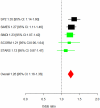Genome-wide meta-analysis of five Asian cohorts identifies PDGFRA as a susceptibility locus for corneal astigmatism
- PMID: 22144915
- PMCID: PMC3228826
- DOI: 10.1371/journal.pgen.1002402
Genome-wide meta-analysis of five Asian cohorts identifies PDGFRA as a susceptibility locus for corneal astigmatism
Abstract
Corneal astigmatism refers to refractive abnormalities and irregularities in the curvature of the cornea, and this interferes with light being accurately focused at a single point in the eye. This ametropic condition is highly prevalent, influences visual acuity, and is a highly heritable trait. There is currently a paucity of research in the genetic etiology of corneal astigmatism. Here we report the results from five genome-wide association studies of corneal astigmatism across three Asian populations, with an initial discovery set of 4,254 Chinese and Malay individuals consisting of 2,249 cases and 2,005 controls. Replication was obtained from three surveys comprising of 2,139 Indians, an additional 929 Chinese children, and an independent 397 Chinese family trios. Variants in PDGFRA on chromosome 4q12 (lead SNP: rs7677751, allelic odds ratio = 1.26 (95% CI: 1.16-1.36), P(meta) = 7.87×10(-9)) were identified to be significantly associated with corneal astigmatism, exhibiting consistent effect sizes across all five cohorts. This highlights the potential role of variants in PDGFRA in the genetic etiology of corneal astigmatism across diverse Asian populations.
Conflict of interest statement
The authors have declared that no competing interests exist.
Figures


Similar articles
-
A genome-wide association study of corneal astigmatism: The CREAM Consortium.Mol Vis. 2018 Feb 5;24:127-142. eCollection 2018. Mol Vis. 2018. PMID: 29422769 Free PMC article.
-
A genome-wide association study for corneal curvature identifies the platelet-derived growth factor receptor α gene as a quantitative trait locus for eye size in white Europeans.Mol Vis. 2013;19:243-53. Epub 2013 Jan 3. Mol Vis. 2013. PMID: 23401653 Free PMC article.
-
Interrogation of the platelet-derived growth factor receptor alpha locus and corneal astigmatism in Australians of Northern European ancestry: results of a genome-wide association study.Mol Vis. 2013 Jun 6;19:1238-46. Print 2013. Mol Vis. 2013. PMID: 23761726 Free PMC article.
-
Association of variants in FRAP1 and PDGFRA with corneal curvature in Asian populations from Singapore.Hum Mol Genet. 2011 Sep 15;20(18):3693-8. doi: 10.1093/hmg/ddr269. Epub 2011 Jun 10. Hum Mol Genet. 2011. PMID: 21665993
-
Association of PDGFRA polymorphisms with the risk of corneal astigmatism in a Japanese population.Sci Rep. 2023 Sep 26;13(1):16075. doi: 10.1038/s41598-023-43333-1. Sci Rep. 2023. PMID: 37752244 Free PMC article.
Cited by
-
Prevalence and risk factors for astigmatism in 7 to 19-year-old students in Xinjiang, China: a cross-sectional study.BMC Ophthalmol. 2024 Mar 13;24(1):116. doi: 10.1186/s12886-024-03382-0. BMC Ophthalmol. 2024. PMID: 38481203 Free PMC article.
-
Genetic Variants Associated With Human Eye Size Are Distinct From Those Conferring Susceptibility to Myopia.Invest Ophthalmol Vis Sci. 2021 Oct 4;62(13):24. doi: 10.1167/iovs.62.13.24. Invest Ophthalmol Vis Sci. 2021. PMID: 34698770 Free PMC article.
-
A genome-wide association study of corneal astigmatism: The CREAM Consortium.Mol Vis. 2018 Feb 5;24:127-142. eCollection 2018. Mol Vis. 2018. PMID: 29422769 Free PMC article.
-
Genome-wide association studies: applications and insights gained in Ophthalmology.Eye (Lond). 2014 Sep;28(9):1066-79. doi: 10.1038/eye.2014.145. Epub 2014 Jun 27. Eye (Lond). 2014. PMID: 24971990 Free PMC article. Review.
-
Longitudinal change in components of astigmatism and its association with axial length-corneal radius ratio in Chinese young children: the Nanjing Eye Study.Graefes Arch Clin Exp Ophthalmol. 2022 Jan;260(1):335-343. doi: 10.1007/s00417-021-05386-8. Epub 2021 Aug 26. Graefes Arch Clin Exp Ophthalmol. 2022. PMID: 34436647
References
-
- Read SA, Collins MJ, Carney LG. A review of astigmatism and its possible genesis. Clin Exp Optom. 2007;90:5–19. - PubMed
-
- Keller PR, Collins MJ, Carney LG, Davis BA, van Saarloos PP. The relation between corneal and total astigmatism. Optom Vis Sci. 1996;73:86–91. - PubMed
-
- Wang Y, Liang YB, Sun LP, Duan XR, Yuan RZ, et al. Prevalence and causes of amblyopia in a rural adult population of Chinese the Handan Eye Study. Ophthalmology. 2011;118:279–283. - PubMed
Publication types
MeSH terms
Substances
Grants and funding
LinkOut - more resources
Full Text Sources
Medical
Miscellaneous

